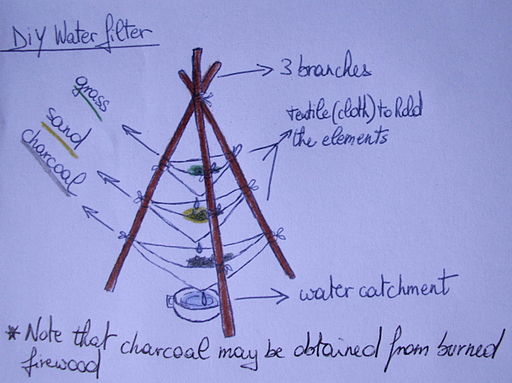DIY Water Filter: Using Sand and Charcoal to Make an Emergency Water Filter
A DIY water filter is a smart solution in today’s times, as the price of bottled water keeps rising, and recycling is becoming a more prevalent issue. Additionally, the cost of manufactured filters, such as Brita, can be expensive depending upon how much water you drink and how often you change the filter.

It is not difficult to filter your own water and you can easily find the inexpensive supplies needed at a gardening store or large franchise, such as Home Depot or Wal-Mart. Prior to gathering your supplies, you should be aware of the various filtration options, their benefits and downfalls, so you can make the best decision for filtering your water.
Simple DIY Water Filter
The simplest form of a water filter DIY requires no sand, no coal and has only four components-the lid, which will cover the ceramic pot, which will fit in the receptacle tank, which will attach to the spigot. Before using the ceramic pot for the first time it is important to clean it, without the use of soap, either by soaking it for 12 hours in clear water or filling it three times, allowing it to empty on its own each time. To clean the spigot and receptacle tank, you will use soap and water but it is important that you rinse these items thoroughly.
Once you are ready to filter the water, simply pour it into the ceramic pot and cover it with the lid. If the water you are using contains a lot of small particles or dirt you may want to cover the ceramic pot with a mesh cloth, using a rubber band to secure it, prior to filling the pot with water. For best results, keep the pot full, clean the filtration system once a month and replace the ceramic pot every three years.
Sand
The water filter DIY with sand is quite different from the simple filtration system, as it requires more components and is a more complex, but better, way to clean your water. If you choose to create a sand filter, you have the option of making a slow or fast filtration system, both of which are effective.
To create a slow water filter DIY using sand, you need a bucket, with a layer of gravel at the bottom, an equal amount of coarse sand above it and a large amount of fine sand on top. A diffuser plate, which acts like a strainer, should be set an inch or two above the top layer of sand, allowing room for the water to sit after you pour it into the bucket. At the bottom of the bucket, you need an outlet with an inline disk filter, which will sit inside the PVC pipe or spigot, so that the water may drain without any debris or particles of sand.
A fast sand filter requires no diffuser plate, no coarse sand and less fine sand but you do need a liner, such as a thick plastic bag. The process is otherwise the same as slow sand filtration.
Charcoal
The use of charcoal as a DIY water filter has been around since ancient times and is probably the best method for filtering water, as it helps to eliminate contaminants as well as debris. This system is also the most complex and likely to be the more expensive of the other options, as it requires the use of a germicidal UV lamp and a photovoltaic panel or a simple outdoor socket to supply the lamp with electricity.
The bucket is set up similarly to the one used for sand filtration, as it needs a layer of gravel at the bottom and sand at the top with a diffuser plate, but also pulverized charcoal in the middle. A perforated pipe connecting to a clear, sealed box allows the water to exit and gain exposure to the UV lamp prior to exiting through one last pipe.
When it comes to creating a DIY water filter, you have options but it is important to consider how you are using the water after filtration. For instance, cleaning bath water using the fast sand method is fine for watering the garden but not for drinking. The charcoal process is best for drinking water, as it has the approval of the EPA and the World Health Organization but you may want to do more research to ensure you do not drink anything that possibly still has contaminants or pathogens.





New! Comments
Have your say about what you just read! Leave me a comment in the box below.